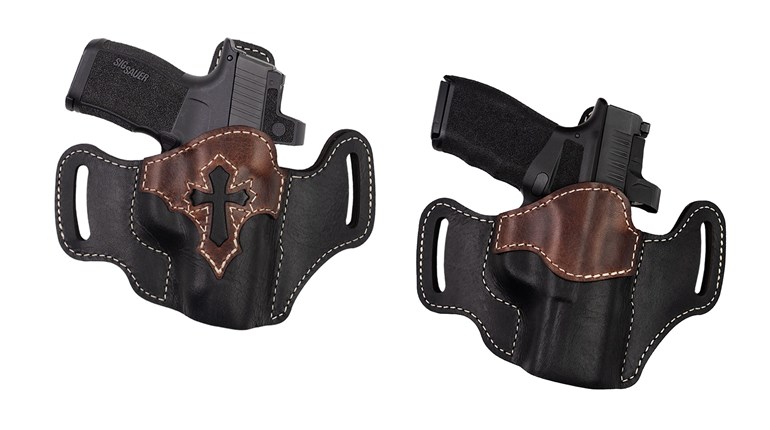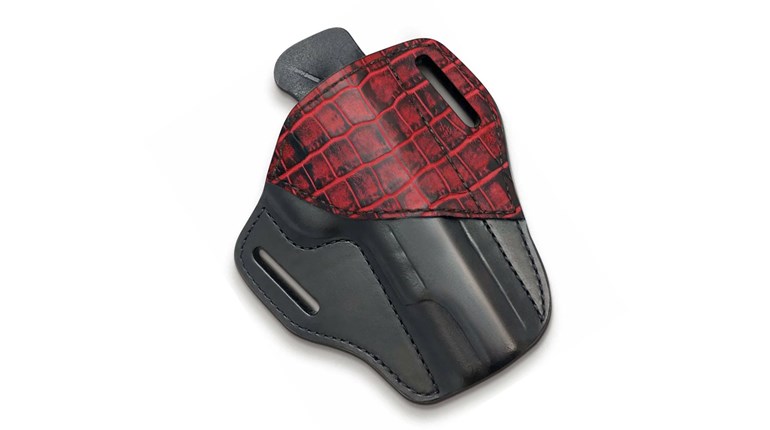
To select an optimal, quality concealed-carry holster, it's important to remember that a holster is more than a gun bucket. It must meet specific requirements for safety and retention. Most mass-produced handguns can be used effectively for self-defense as long as the user's skill is up to par, but a poor holster can be a serious liability. Modern handgun choices have never been better, but unfortunately for every quality holster out there, it is easy to find several that have serious flaws that make them sub-optimal for everyday carry. It's important to consider the criteria of safety, retention and ease of use when selecting a holster in order to avoid ending up with the common box of discarded, unsatisfactory holsters like you might find in the garage of many experienced concealed-carriers.
Let’s start with a broader question: Do you really need a holster? Sticking an unholstered handgun in your waistband is unsafe and the gun can shift in ways that make it much harder to use as effectively when needed. Other options beyond a naked gun in a waistband include off-body carry in a bag and storing the firearm in your car. However, off-body and car-carry present challenges and issues that can be easily solved by carrying on-body in a quality holster, and that’s what I recommend whenever possible.
What's Important? Location, Location, Location
 Selecting a holster, we must first determine the location of carry. Common methods include outside-the-waistband (OWB), inside-the-waistband (IWB), and Appendix IWB (AIWB). Other methods like cross-draw, small-of-back carry and shoulder holsters are less common and may have limitations such as difficulty in training safely on a public range without pointing the muzzle at other shooters, slowing your draw and having the draw being more easily disrupted by an attacker. Ankle holsters may be suitable for backup guns or other specific applications, but for most people, OWB, IWB or AIWB is recommended.
Selecting a holster, we must first determine the location of carry. Common methods include outside-the-waistband (OWB), inside-the-waistband (IWB), and Appendix IWB (AIWB). Other methods like cross-draw, small-of-back carry and shoulder holsters are less common and may have limitations such as difficulty in training safely on a public range without pointing the muzzle at other shooters, slowing your draw and having the draw being more easily disrupted by an attacker. Ankle holsters may be suitable for backup guns or other specific applications, but for most people, OWB, IWB or AIWB is recommended.
When choosing between OWB, IWB and AIWB, consider concealment, comfort and fast, reliable access. OWB is comfortable but harder to conceal, IWB is more concealed but less comfortable and AIWB is concealed and fast, but may be less comfortable for some body types. The key is to consider your lifestyle and pick the method that offers the right balance of concealment, comfort and safety for you. Each method has its pros and cons, and it's essential to experiment to find what works best for your personal wardrobe, body shape, and lifestyle.
Material Issues
 Two primary materials used in holsters are leather and Kydex. Leather is traditional and comfortable, but requires break-in and can absorb moisture and wear out over time. Kydex is cheaper, impervious to moisture and requires no break-in period, but can be harder on a handgun's finish and less comfortable against the skin. Both require inspection and maintenance to ensure they are in good condition. Regarding hybrid holsters, which are typically made of Kydex outer shells on inner leather backers, I suggest choosing a holster made of one material. Hybrid holsters can develop issues with retention and safety over time; as the leather side of the holster breaks in, retention is negatively affected, and the leather sweatguard often curls outward becoming an obstacle and potential hazard while holstering. If you do choose a hybrid holster, regularly check retention and the condition of the sweat-guard and replace if necessary.
Two primary materials used in holsters are leather and Kydex. Leather is traditional and comfortable, but requires break-in and can absorb moisture and wear out over time. Kydex is cheaper, impervious to moisture and requires no break-in period, but can be harder on a handgun's finish and less comfortable against the skin. Both require inspection and maintenance to ensure they are in good condition. Regarding hybrid holsters, which are typically made of Kydex outer shells on inner leather backers, I suggest choosing a holster made of one material. Hybrid holsters can develop issues with retention and safety over time; as the leather side of the holster breaks in, retention is negatively affected, and the leather sweatguard often curls outward becoming an obstacle and potential hazard while holstering. If you do choose a hybrid holster, regularly check retention and the condition of the sweat-guard and replace if necessary.
It's essential to choose a holster that is specifically made for the make and model of your handgun. Universal holsters may seem like a good idea, but they often have issues with retention, trigger guard coverage and other essential aspects of holsters. Because of these issues, it's better to invest in a holster that is tailored to your specific firearm.
Choose Safety First
 Whether OWB, IWB or AIWB, leather or Kydex, there are three non-negotiable criteria to look for in a holster. First, the holster must completely cover the trigger guard of the gun, preventing anything from activating the trigger while the gun is holstered. Any holster that fails to do this (with extremely rare and application-specific exceptions) is not a safe holster. One caveat is that holsters for weapon-mounted lights (WML) by necessity leave a small gap around the trigger-guard, and there is no avoiding it. If a WML is essential, then this gap must be tolerated and the additional risk mitigated by increased awareness of the space around the gun as it rests in the holster.
Whether OWB, IWB or AIWB, leather or Kydex, there are three non-negotiable criteria to look for in a holster. First, the holster must completely cover the trigger guard of the gun, preventing anything from activating the trigger while the gun is holstered. Any holster that fails to do this (with extremely rare and application-specific exceptions) is not a safe holster. One caveat is that holsters for weapon-mounted lights (WML) by necessity leave a small gap around the trigger-guard, and there is no avoiding it. If a WML is essential, then this gap must be tolerated and the additional risk mitigated by increased awareness of the space around the gun as it rests in the holster.
Another essential quality for a holster is that it retains the firearm securely and keeps it in a secure position against the body without excessive shifting or movement. A popular social media test of shaking the holster upside down and declaring it inadequate if the gun falls out is not a reliable way to measure retention, because it does not replicate actual carry conditions. Quality holsters designed for OWB, IWB or AIWB, gain retention not only from internal tension on the gun, but also from added external tension placed on the gun by the belt when the holster is worn. If the gun does not shift or come out of the worn holster when jumping up and down vigorously, the retention is probably adequate. If not, it's time to find a new holster.
A critical aspect of retention is keeping the gun and holster attached to the body. To avoid having the holster come out with the gun during the draw stroke or falling out of waistbands during vigorous movement, choose holsters with secure attachment points such as closed loops, pull-the-dot loops or heavy duty metal clips. All of these should be sized to the belt properly and quality metal clips should have an "underhook" that grabs the bottom of the belt. Some plastic clips can be a problem as they may not be secure enough during vigorous movement and are more prone to breakage, so if you use plastic clips (and there are a handful of quality options out there), make sure you pressure-test them through serious training.
Reholster With Confidence
A holster's mouth must be stiff enough to remain open when empty and mounted on the belt, in order to facilitate safe holstering. Holstering is the most dangerous part of gun handling as the shooter is moving the muzzle of a loaded gun near their body. A holster that collapses when the gun is drawn, which often requires use of the support hand to manually reopen it for holster, increases the likelihood of pointing the muzzle at the support hand or other parts of the body when distracted during long training sessions. Quality holsters that remain fully open after the gun is drawn are essential.
Ultimately, holsters are a huge part of safe and effective concealed carry. Quality handguns are typically several hundred dollars, ranging up to several thousand. Quality holsters are typically around or less than $100, with some handmade leather options climbing into the low hundreds. Does it make any sense to carry our several hundred-dollar pistol, a life-saving tool, in a holster that was $20 cheaper than its superior competitor? A holster is so important to training with and carrying a handgun that if someone’s budget was that constrained, they’d be better off buying a slightly more affordable handgun and getting the highest quality holster. Holsters really are that important to both safety and rapid access of the handgun. So no matter the location of your holster choice or its material, the essentials are a purpose-built design for your specific handgun that protects trigger, retains the gun and keeps the mouth of the holster open without the gun in it. If you follow these guidelines, you can train and carry with confidence, and avoid suffering the fate of so many concealed-carriers who’ve come before: A box full of discarded holsters in the garage, representing wasted time and money.



































